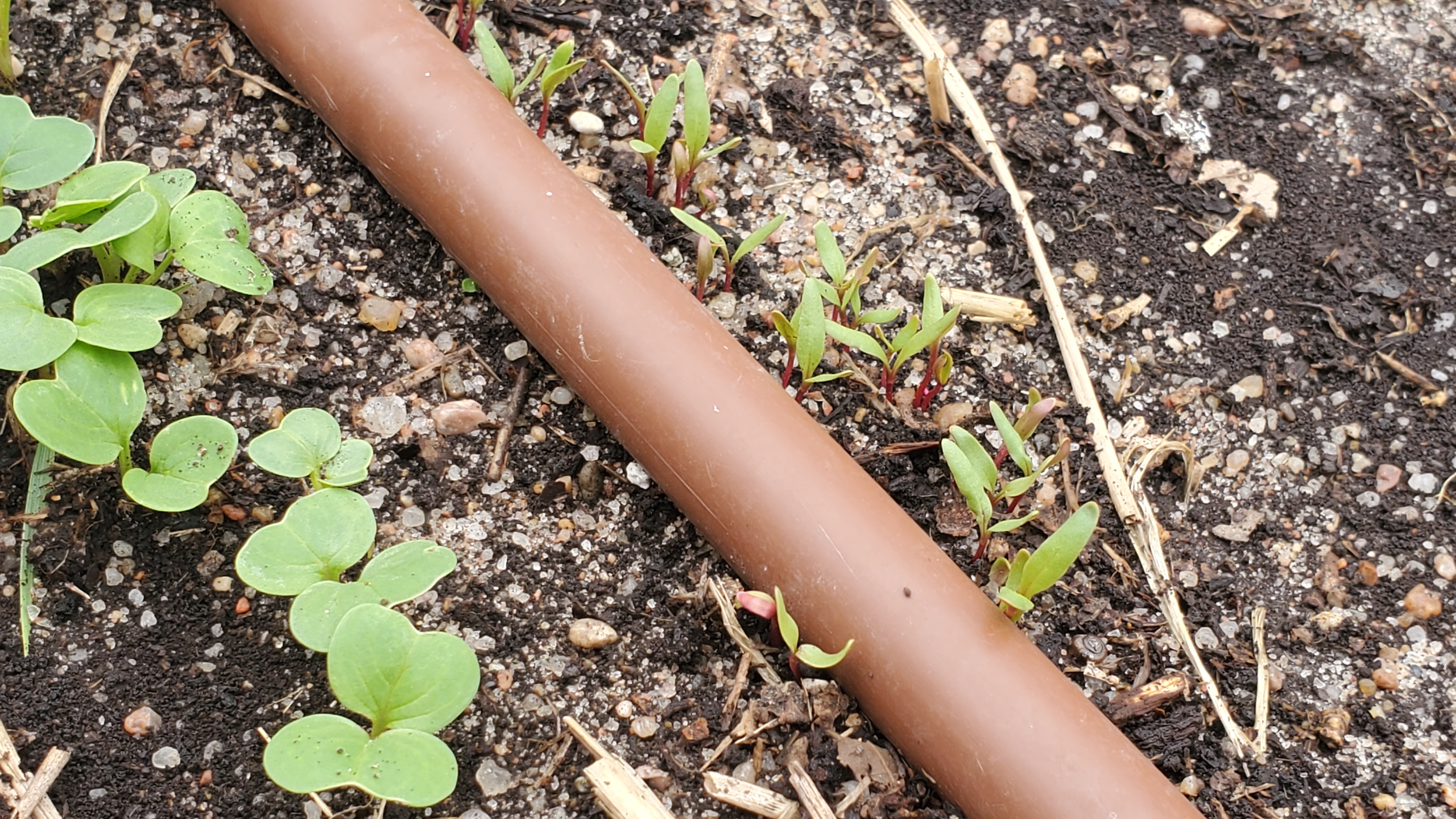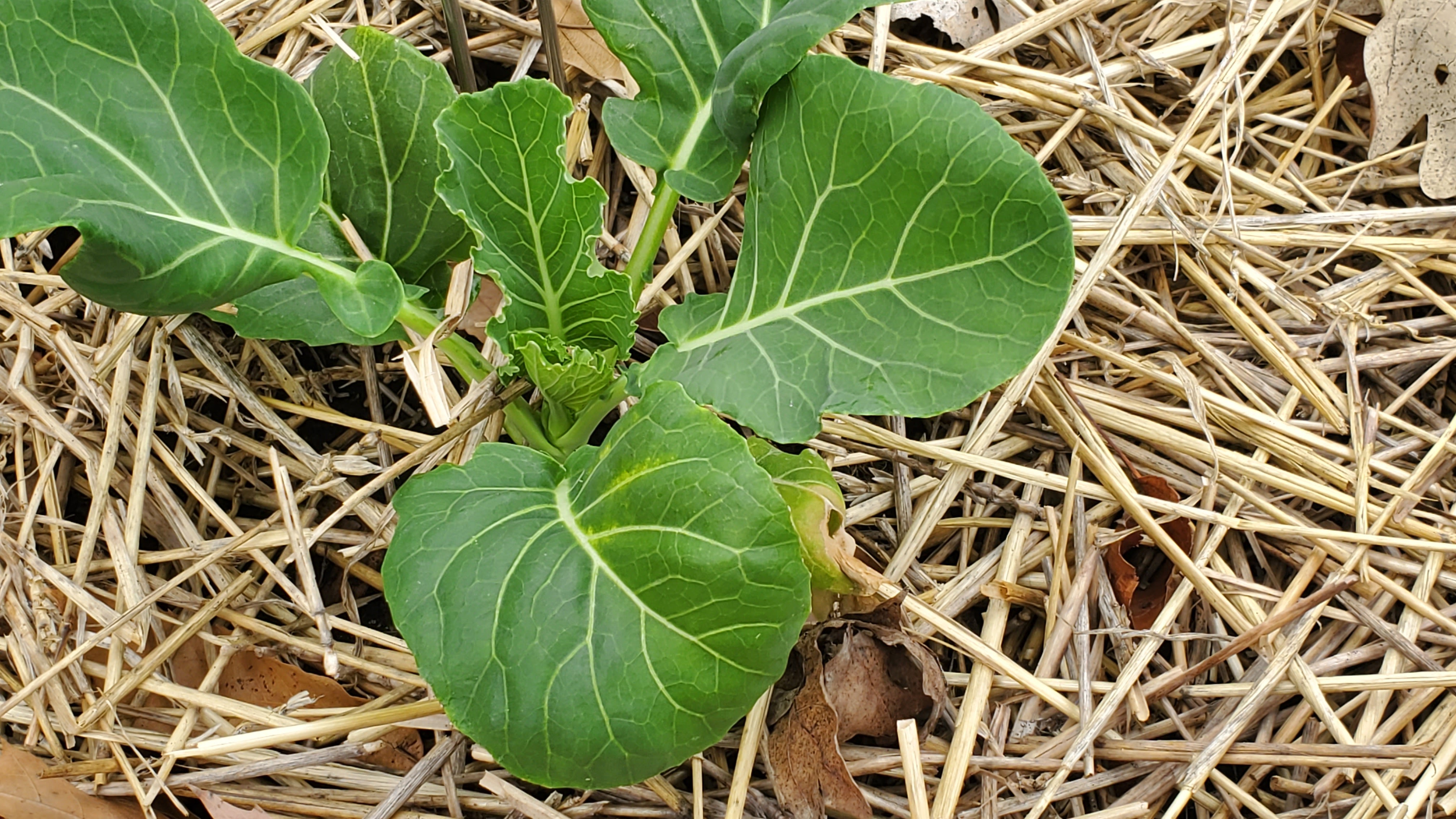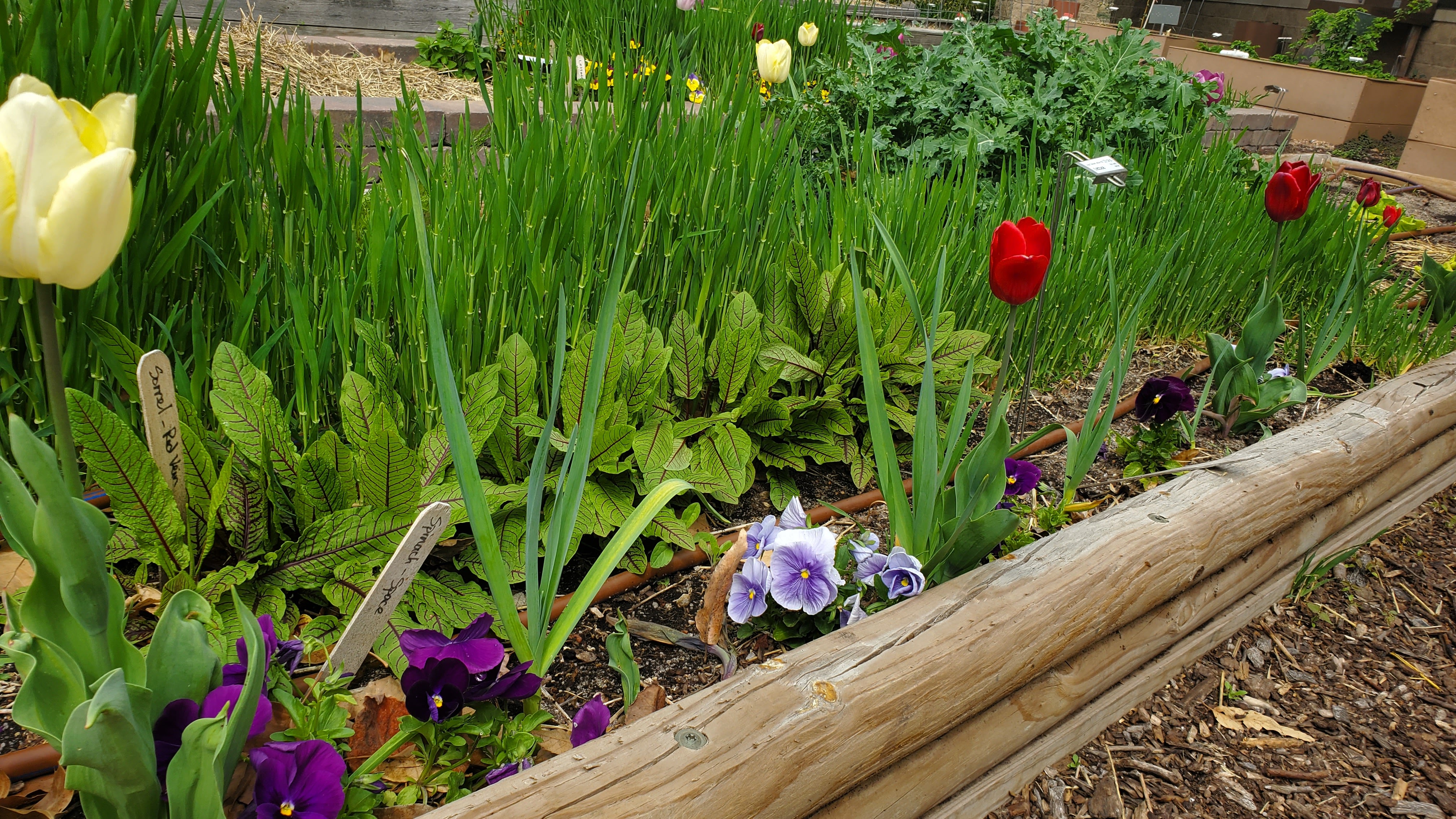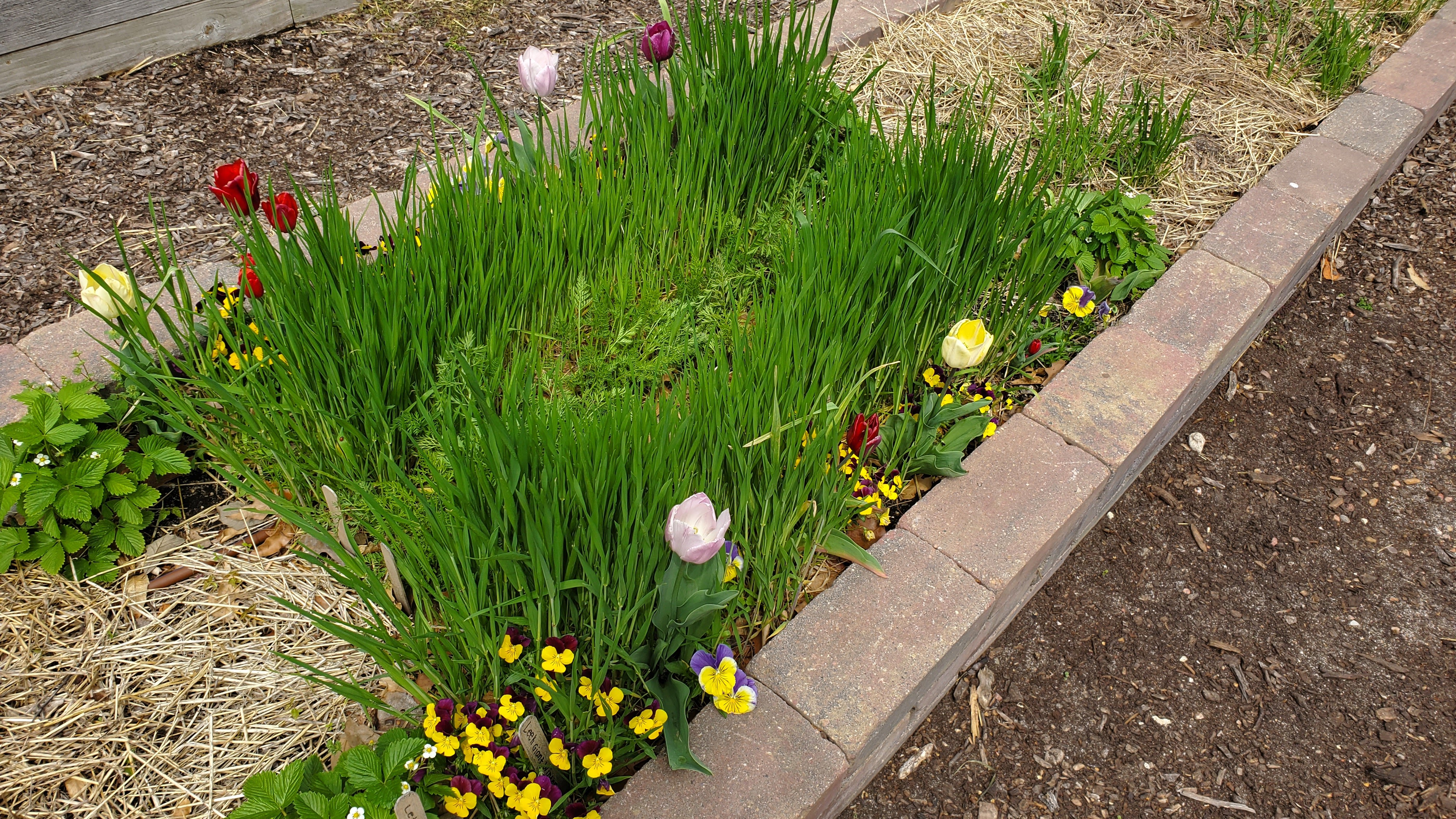Blog Archives
2021 Demo Garden Plans and Updates
Our Demo Garden plantings are well underway for this year, and we already have some exciting things to showcase. But first – here’s a quick overview of what we are planning to grow this year!

We chose to continue to focus our garden efforts on productivity and yield over diversity for this year. We are planning to continue donating our harvests to the Common Ground Producers & Growers Mobile Market for their Seniors First food box program, which provides free food boxes to low income seniors.
With that in mind, we are keeping each garden bed to only a couple different types of produce, although we still have more diversity of varieties than you might otherwise see. We are also focusing on interplanting and succession planting to use our space well. For example, in bed 1, we have radishes planted between rows of beets and carrots and IN the row with the parsnips to use every square inch of space. In Bed 2, we are filling the space with lettuce and spinach now, and then the peppers for the remainder of the season will be planted into the leafy greens while they finish their spring season. In Beds 4 and 5, we have planted broccoli, cauliflower, and peas under the trellises that will hold the cucumbers and squash later in the summer to get an additional crop out of those spaces.
The Master Gardeners have been hard at work getting the garden into shape for the spring, and almost all the beds have either seeds or transplants already growing. We had covered most of the beds with straw last fall, so that is both good and bad now – the soil stays moist with the straw, but we have lots of wheat seedlings growing. We also needed to move quite a bit of the straw around to facilitate seed planting.
The other thing I’m excited to show off a little bit are a couple of the school garden templates that I developed last year and planted last fall.
The templates are 4×8 layouts designed with high diversity (and relatively low productivity) for better interest and learning experiences in a school garden setting. (You can see all the templates and supporting information here: Kansas School Garden Guide.) Both of the templates shown here were designed to be planted last fall and overwintered. These overwintered with NO additional protection from the elements. They include pansies, tulips, garlic, shallots, alpine strawberries, barley or wheat, and vegetables (kale, carrots, red-veined sorrel, spinach).
If you haven’t been out in awhile, our garden is always open to the public – best viewed during daylight hours! Things will be changing fast as it gets warmer, so don’t miss out on the opportunity to visit.
Prepping for Fall & Beating the Heat
Many years, fall is my favorite time in the garden here in Kansas. The tricky thing is getting yourself into a “fall” mindset when it is still blazingly hot in early August. Yes, now is the time to plan, prepare, and plant your fall vegetable garden!
 We started seeds for some of our fall plantings about 4-5 weeks ago: broccoli, cauliflower, Japanese winter bunching onion, kale, and bok choy.
We started seeds for some of our fall plantings about 4-5 weeks ago: broccoli, cauliflower, Japanese winter bunching onion, kale, and bok choy.
I moved them outside onto the table near the building last week, so they don’t look quite this nice anymore. The flea beetles are going to do a number on our fall brassicas, I’m afraid.
Despite the heat, I wanted to get at least some of these plants in the ground, because they are drying out too fast in the cell trays.
Timing isn’t too critical on some of these, but the broccoli and cauliflower may not have a long enough growing season if we don’t plant them soon.
We also have a number or root vegetables that need to be planted soon if we want to get a good crop.
Things like lettuce and spinach need to wait a few more weeks, because the soil is just too warm to plant now. They also grow faster, so we can afford to wait a bit longer to plant.

In preparation for planting some of our root vegetables next week, we put a thick layer of straw mulch down in some of the planting areas. Organic mulches like straw can cool the soil up to 10 degrees in addition to helping with soil moisture. Hopefully we’ll get better germination because of the straw.
For more ideas and techniques about fall vegetable gardens, here are several posts about fall gardening from a few years ago:
Fall Gardening: Why Try It and What to Plant
Fall Gardening: Less Common Vegetables for Kansas
Fall Gardening: Dealing with Late Summer Heat
Fall Gardening: Dealing with Late Fall Cold
Fall Gardening: Kansas Climate Conditions for Extending into the Winter
Garden Work Day in April Weather
Yesterday, although it felt more like April rather than mid-May, we forged ahead with planting our vining vegetables anyway! I’m just tired of waiting on the weather’s pleasure, and the soil is marginally warm enough anyway.
 The main things we had left to plant were the cucumbers, gourds, melon, and pumpkins on the trellises throughout the garden. Here you can see the spinach and mustard still growing well in the trellis area of the Taste of India Garden. Typically we plant on the outside of the trellis, but given the plant and trellis placement this year, we decided to plant the seeds between the drip lines and the edge of the trellis.
The main things we had left to plant were the cucumbers, gourds, melon, and pumpkins on the trellises throughout the garden. Here you can see the spinach and mustard still growing well in the trellis area of the Taste of India Garden. Typically we plant on the outside of the trellis, but given the plant and trellis placement this year, we decided to plant the seeds between the drip lines and the edge of the trellis.
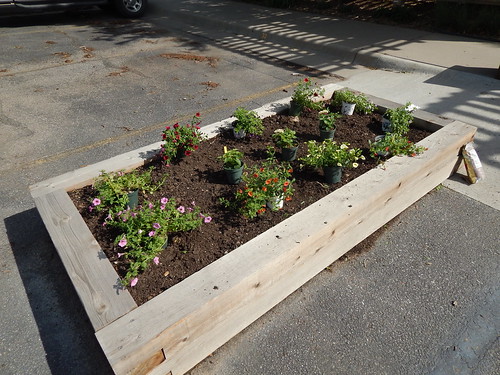 We also had the Prairie Star Annual flower trials to plant this week. The entry gardens, quiet garden, and some containers were planted with the flowers in the Prairie Star trial. We’ll be keeping an eye on them all summer long to see how they do.
We also had the Prairie Star Annual flower trials to plant this week. The entry gardens, quiet garden, and some containers were planted with the flowers in the Prairie Star trial. We’ll be keeping an eye on them all summer long to see how they do.
 Since only 3 of the original strawberry plants survived, we planted a few more plants of two different varieties that I was able to find locally. We added 7 Ozark Beauty plants and 5 Quinalt plants to our mix. I hope we have better luck with these! The rest of the garden we will plant to some flowers or herbs or something else. We’ll wait and see!
Since only 3 of the original strawberry plants survived, we planted a few more plants of two different varieties that I was able to find locally. We added 7 Ozark Beauty plants and 5 Quinalt plants to our mix. I hope we have better luck with these! The rest of the garden we will plant to some flowers or herbs or something else. We’ll wait and see!
Except for a few miscellaneous things, we are almost done with planting for the year. It will be fun to see how things grow!
Friday PhotoEssay
Welcome to our 2nd Friday PhotoEssay of the season! I don’t have much more to show you beyond what we had earlier in the week, but there are a few things.
 It would appear that our drainage system works. On one hand, that’s good. On the other hand, this is the water running out as we were busily trying to get the soil in our raised beds moist enough to plant in on Tuesday. Hmm…
It would appear that our drainage system works. On one hand, that’s good. On the other hand, this is the water running out as we were busily trying to get the soil in our raised beds moist enough to plant in on Tuesday. Hmm…
 On closer examination, it appears that we may be making compost tea as we try to get the beds thoroughly moist. Not very thrilled with that…both from the nutrient loss standpoint and the sending nutrients into the sewers standpoint. Any ideas? The seeping is too low and slow to really capture that water.
On closer examination, it appears that we may be making compost tea as we try to get the beds thoroughly moist. Not very thrilled with that…both from the nutrient loss standpoint and the sending nutrients into the sewers standpoint. Any ideas? The seeping is too low and slow to really capture that water.
 One part of the garden that isn’t fully finished yet is our Wheelchair/Accessible garden. It is still in the planning and design stage. Meanwhile, we have this wheeled container cart holding the spot. Our Horticulture Therapy committee has an eggplant and a pepper in two of the pots right now, and will be adding a tomato shortly.
One part of the garden that isn’t fully finished yet is our Wheelchair/Accessible garden. It is still in the planning and design stage. Meanwhile, we have this wheeled container cart holding the spot. Our Horticulture Therapy committee has an eggplant and a pepper in two of the pots right now, and will be adding a tomato shortly.
 In the Beautiful Vegetables garden we planted some black sesame. The seeds (not surprisingly!) look like black-colored sesame seeds.
In the Beautiful Vegetables garden we planted some black sesame. The seeds (not surprisingly!) look like black-colored sesame seeds.
 We cut the top 3-4 inches off of the Cardinal Basil plants that we planted on Tuesday. Even though these are a little muddy, they are too good to waste! This is a quick way to get the first basil of the season. Our speaker at Herb Day, Jim Long, also talked about how important it is to constantly be cutting herbs back to keep them flavorful.
We cut the top 3-4 inches off of the Cardinal Basil plants that we planted on Tuesday. Even though these are a little muddy, they are too good to waste! This is a quick way to get the first basil of the season. Our speaker at Herb Day, Jim Long, also talked about how important it is to constantly be cutting herbs back to keep them flavorful.
Have a great weekend!

